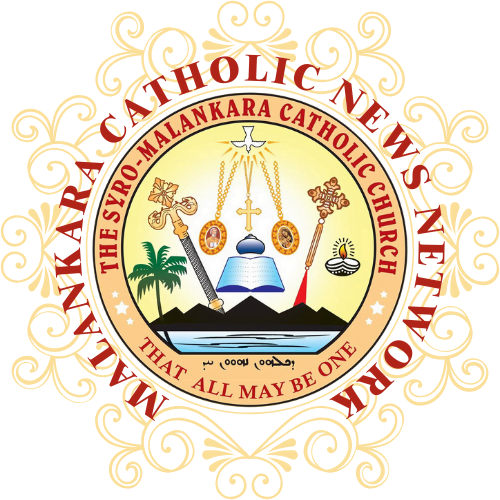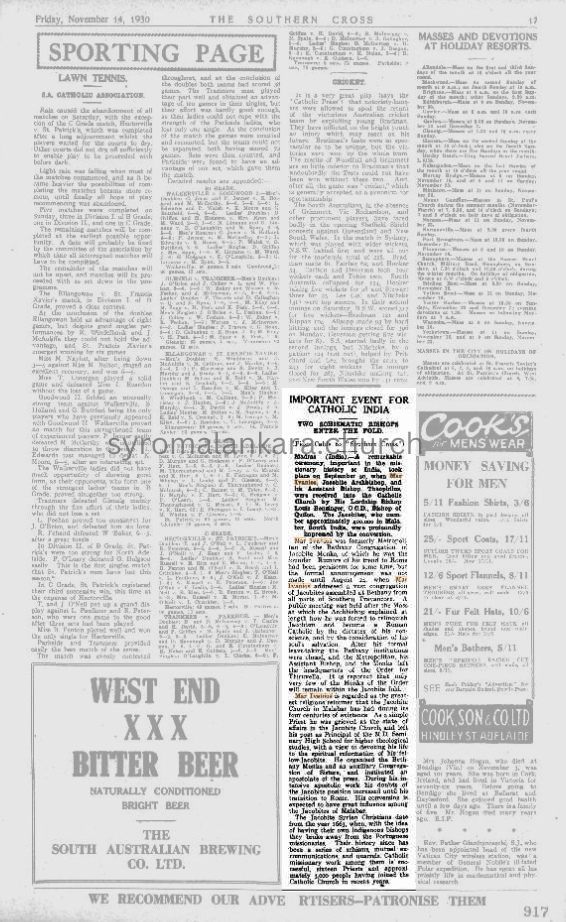Jacobites In India Are Stirred as Most Learned Prelates Come Over.
GENERAL EXODUS BEGINS
Besides Bishops, Nuns and Monks Are Embracing Catholicism.
By REV. JOSEPH C. PANJIKARAN, Ph. D., D. D.
(By N. C. W. C. News Service)
Ernakulam, India, —
Events are following immediately upon the reception into the Catholic Church of Archbishop Mar Ivanios, the Jacobite prelate, at Quilon recently, bringing ever nearer to realization the total conversion of the Jacobite community in Malabar, which numbers 350,000 souls.
The conversion of Mar Ivanios, the Metropolitan of Bethany, and the Jacobite Bishop of Tiruvella, Mar Theophilos, who entered the Church with him, was followed the next day by the reception of a community of Jacobite Sisters, numbering more than a dozen, and a Jacobite community of monks.
These conversions were followed by those of two Rambans, the next highest in rank to the Jacobite bishops, and also some of the leading laymen. News of the conversions has spread like wildfire and has stirred the whole of Christian and even pagan Malabar.
The answer to the situation is to be found directly in the Bethany Movement in the Syrian Jacobite Church of Malabar. It is believed by many students of the matter here that the movement, plus the remarkable recent conversions, constitute a blow from which the entire Jacobite Church cannot rally, and that eventually the whole group will come into the Catholic Church. In any case, it is held certain that many more leading Jacobites will become Catholics.
This Bethany Movement, started by Mar Ivanios while he was the Rev. P. T. Geevarghese, is taking the same lines as the Tractarian Movement led by Newman.
Mar Ivanios is Leader
Mar Ivanios is the leader of the movement. He is a Master of Arts of the Madras University and was the principal of the M. D. Seminary, the leading educational institution of the Syrian Jacobites of Malabar. While serving in that post, he received the offer of a professorship in the Divinity College of Serampore, Calcutta. He accepted the offer and went to Calcutta. A number of Malabar students then came flocking to Serampore and with some of these he began to lead a sort of monastic community life.
Mar Ivanios is the most learned of all the Jacobite bishops in Malabar. He is 47 years old, strongly built and has a tender and winning personality. His great idea was to start an Ashram of Jacobite monks following the rule of St. Basil in Malabar.
With the help of Protestant friends he began his Ashram at Mulanthuruthy, near Trichur, in 1910. The members of the Ashram devoted themselves to prayer, study and manual labor. The movement spread rapidly and the number of inmates increased steadily.
The Ashram was affiliated to the Jacobite Church in 1913 and Mar Ivanios was made its head. The members took a vow of poverty, chastity and obedience.
The movement attracted considerable attention throughout Malabar and even beyond. There was some opposition from a section of the conservative Jacobites, but the movement continued to grow.
In 1925, Mar Ivanios was consecrated a bishop by three bishops of the Assyrian Church of the East. This consecration was not recognized by the Jacobite Patriarch of Antioch and a controversy arose.
Mar Ivanios and his followers contended that their rite and liturgy were more akin to those of the early Church than those of the present Jacobite Church. They also emphasized the importance of a closer union with the Catholic Church.
Negotiations for reunion with Rome were opened in 1927 and these negotiations culminated in the recent submission of Mar Ivanios and his followers to the Pope.
The submission was made on March 20, 1930, and was accepted by the Pope on April 18th of the same year. Mar Ivanios was received into the Catholic Church on May 6th.
The conversion of Mar Ivanios and his followers is a momentous event in the history of Christianity in India. It is believed that it will pave the way for the reunion with Rome of the entire Jacobite Church.\
Copyright: The Tablet, Brooklyn, New York, Sat, Nov 15, 1930





